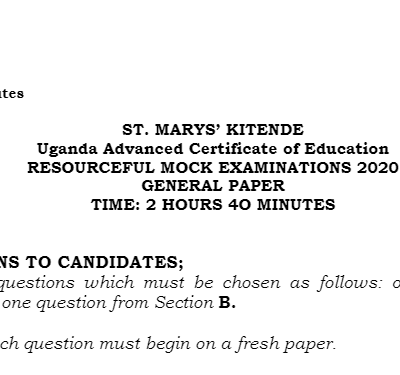P230/3
ENTREPRENEURSHIP
EDUCATION
PAPER 3
3 HOURS
UGANDA ADVANCED CERTIFICATE OF EDUCATION
Pre- Registration Examinations 2016
ENTREPRENEURSHIP EDUCATION
PAPER 3
3 HOURS
Instructions;
- This paper consists of three sections A, B and C.
- Answer four questions only. All questions carry equal marks.
- Section A is compulsory. Answer any three questions from sections B and C, choosing at least one question from each section.
- Credit will be given for use of relevant diagrams and illustrations.
- Any additional question(s) answered will not be marked.
SECTION A: CASE STUDY
1. Read the case study below and answer the questions that follow;
Elizabeth, an orphan, grew into a successful social Entrepreneur. As a youth, she performed all types of work and associated with many people in her community. This enabled her to acquire diverse skills in production, marketing, customer care and ability to identify business opportunities. She also developed good interpersonal and effective communication skills and ability to speak in many languages.
Having scanned the environment around her, Elizabeth started a goat rearing project using her scarce resources. The project picked up after five years and Elizabeth hatched an idea of involving the whole community around her to improve their livelihood.
She organised a meeting and shared her intended community development plan. Some members expressed fears that there were limited benefits from the proposed project, that it was exploitative, unsustainable and risky. The majority, however, agreed that it was a just, rewarding, participatory and self-sustaining project, open to all members of the community, irrespective of one’s gender, tribe, socio-economic status, religious and political affiliation. The only condition was that a member would receive a free goat from the initial donor, breed it and pass on its female off-spring to the next beneficially.
Members agreed to insure the project against risks. In the event of a goat producing only male off-springs, Elizabeth promised to exchange a female goat for two of these. At the inception of the project, Elizabeth donated 100 goats at a colourful ceremony attended by political, religious and clan leaders.
After two years, the community realized a number of benefits from the project; development of livestock and pasture management skills, increased incomes through the sale of animal products, improved nutrition and food security, cheap energy and manure from animal droppings.
During the annual community celebrations, Elizabeth was declared the heroine of the year for initiating a life-changing project.
a) Identify the different skills that Elizabeth employed to transform her community. (4 marks)
b) Explain the strategies put in place to ensure the sustainability of the project.
(8 marks)
c) Giving reasons for your answer, suggest insurance policies that should be taken to minimize risks in the community project. (8 marks)
d) In what ways did the project contribute to the development of the community? (5 marks)
Section B: school business club
Answer at least one question from this section.
2. Based on your school Entrepreneurship club business project,
a) Describe the project. (4 marks)
b) State the objectives of the business. (3 marks)
c) Describe the entrepreneurship skills that were applied in the business.
(6 marks)
d. i) What challenges were faced by the business? (6 marks)
ii) How were the challenges mentioned in 2d(i) above managed? (6 marks)
3. In relation to your school Entrepreneurship Club Business Project;
a) Describe the business project. (4 marks)
b) State the achievements of the business. (4 marks)
c) Use SWOT analysis to evaluate the business. (12 marks)
d) What measures were used to maintain the quality of the product(s)?
(5 marks)
SECTION C: FIELD ATTACHMENT/ FILED TRIP
Answer at least one question from this section.
4. For any business enterprise you were attached to;
a) Describe the nature of the business. (4 marks)
b. i) List any five operating expenses of the business. (5 marks)
ii) Suggest measures that should be taken by the entrepreneur to minimize the expenses mentioned in 4(b) (i) above. (5 marks)
c) Mention any five ways used to motivate the employees of the business.
(5 marks)
d) Describe the customer care services offered by the business. (6 marks)
5. With reference to any one business field you made either as an individual or group;
a) Describe the business. (4 marks)
b) Explain the forms of change that have affected the business. ( 6 marks)
c) Assess the impact of the changes mentioned in 5(b) above on the business.
(9 marks)
d) Advise the entrepreneur on any six ways of maintaining the market share of the business. (6 marks)
***END***




